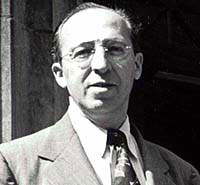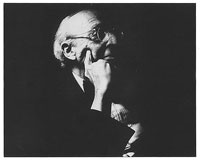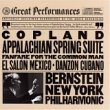More than any other composer, Aaron Copland created a distinctively American musical style in such iconic early works as Fanfare for the Common Man (1942) and Appalachian Spring (1944). His widely spaced chords and vigorous rhythms are often, consciously or unconsciously, incorporated into other composers’ attempts to create an “American” sound. In later years, however, Copland moved away from this musical populism, experimenting with the modernist twelve-tone technique that he had previously rejected. Audiences have yet to embrace Copland’s later works, but his Americanist music remains among the best-loved classical music of the twentieth century.
 Early Music Studies Early Music Studies
Aaron Copland was born in Brooklyn, New York, on November 14, 1900. He was a first-generation American, his Jewish parents having immigrated to the U.S. from Lithuania, then part of Russia. Along the way, the Copland family name was adapted from the original “Kaplan.” His four older siblings had music lessons—violin and piano— but they did not show any outstanding ability, a fact that made his parents reluctant to allow Aaron, the youngest, to study music. Though he learned a little from his sister Laurine in his early childhood, he did not begin piano lessons in earnest until he was thirteen.
Copland began inventing tunes at the piano when he was only nine but first thought of becoming a composer when he was around fifteen years old. As this goal required training in harmony, his piano instructor, Leopold Wolfsohn, arranged for the young Copland to begin studies with Rubin Goldmark. Goldmark had a solid pedigree; his uncle Karl Goldmark was a Hungarian-born composer of some distinction, and Rubin Goldmark had himself been a pupil of Antonin Dvořák. Though Copland did not participate in musical activities in school, he kept up his private studies through and after his 1918 graduation from Boys’ High School. In addition to his composition lessons, between 1917 and 1921 Copland also continued his piano studies with Victor Wittgenstein and Clarence Adler.
Copland’s first compositions under Goldmark’s supervision were conservative and conventional, as Copland later described them, but he was drawn to modernist styles. After Copland brought his teacher a somewhat experimental piano composition called The Cat and the Mouse (1920), Goldmark discouraged him from taking such a path. Following this incident, Copland wrote carefully traditionalist works for his lessons and pieces of a different sort for his own gratification. Jazz also played an important role in his early work, as in his piano suite Three Moods (1920-21).
Studies with Boulanger and Early Career
In 1920, Copland read about a new educational institution abroad for American musicians to be established at the Château de Fontainebleau in Paris. He was anxious to be around other young composers and to study in Europe, so he became one of the very first applicants to the American Conservatory of Music. While at Fontainebleau during the summer of 1921, Copland studied conducting, took piano lessons with Ricardo Viñes, and was convinced to go to Nadia Boulanger’s harmony class.
Boulanger, then in her thirties, had been a child prodigy and a student of composer Gabriel Fauré. She then became a successful organist, composer, and conductor as well as one of Europe’s foremost composition teachers. Copland, like many others at the time, was at first reluctant to study with a woman, but it was his decision to request composition lessons from her. He soon became a devoted pupil—one of the first in a very long line of American composers who benefited from Boulanger’s guidance.
The works Copland produced during his three years in Paris included the four choral Motets (1921), a Passacaglia for piano (1921-2), and a ballet score titled Grohg. Though the latter was Copland’s first orchestrated work, Boulanger was impressed enough to offer her student a commission. She was to perform with the New York and Boston Symphony Orchestras as an organist in two concerts scheduled for early 1925, so she asked Copland to write a composition suitable for organ and orchestra. In the summer of 1924, Copland retuned to New York, immediately commencing the Symphony for Organ and Orchestra. Meanwhile, in November 1924, the League of Composers, a New York-based organization founded the previous year, programmed The Cat and the Mouse and the Passacaglia. This concert launched Copland’s career in earnest.
Since Boulanger’s performance of the Symphony for Organ and Orchestra involved the Boston Symphony Orchestra, Copland’s music came to the attention of the orchestra’s conductor, Serge Koussevitzky. Koussevitzky requested a new piece for the following year, and Copland obliged with the suite for chamber orchestra, Music for the Theatre (1925). Intending the work to convey an especially American character, Copland began to explore more thoroughly the integration of jazz into his compositional style. In 1924, he also published his first major essay, “Gabriel Fauré, A Neglected Master,” in The Musical Quarterly. The article was printed shortly before Fauré’s death.
Copland tried to survive by his work as a composer and writer, as well as by his attempts at teaching, but he could not find any students. Fortunately, his financial concerns were soon alleviated when he was given a Guggenheim Memorial Foundation fellowship, the first such award to a composer. In the summer of 1925, the award enabled him to repair to the MacDowell Colony in New Hampshire to focus on his new work.
At the MacDowell Colony, Copland met fellow composers Roy Harris and Roger Sessions. From 1928 until 1931, Sessions and Copland coordinated a performance series called the Copland-Sessions Concerts, meant to promote American music. Copland continued supporting American composers throughout his life.
New Influences
After Music for the Theatre, Copland wrote the less successful Concerto for Piano and Orchestra, his last effort with the musical language of jazz. Next came the Symphonic Ode (1927-9), the Dance Symphony (reworked from Grohg, 1929), the Piano Variations (1930), and the Short Symphony (Symphony No. 2, 1932).
In 1927, Copland began lecturing at the New School for Social Research in New York. He continued there for more than a decade, eventually gathering some of his ideas from the lectures into a book, What to Listen for in Music (1939). During the 1930s, he also became active in several composers’ organizations, including the American Composers’ Alliance (est. 1937) and the American Music Center (est. 1939). He was instrumental in the establishment of Cos Cob Press, a publishing company focusing on American works.
Copland’s involvement with the New School and other activities put him in contact with a number of important leftist artists, musicians, and intellectuals. While Copland never joined the Communist or Socialist parties, his association with such politics would later cause him some trouble. A particular problem for anti-Communists was Copland’s 1934 publication of a choral piece setting Alfred Hayes’ poem “Into the Streets of May First,” in the communist periodical New Masses.
Copland made a trip to Mexico in 1932, at the request of his friend Carlos Chávez, a significant composer in his own right. In September, Chávez conducted an all-Copland program at the Conservatorio Nacional in Mexico City. While visiting Mexico, Copland was inspired by Chávez’ use of folk music in the service of musical nationalism, as well as by a book of Mexican folk songs illustrated by Rufino Tamayo. The songs in the Cancionero Mexicano (1931) had been collected by anthropologist Frances Toor (associated with another of Copland’s friends, the famed muralist Diego Rivera). It was after Toor gave Copland a copy of the Cancionero that the composer wrote El Salón México (completed 1936), one of his most beloved works. Soon, American folk material would become a fundamental element of Copland’s music, as he put to work the nationalist techniques he heard in Mexico.
Copland’s traveling companion on the Mexico trip was photographer Victor Kraft, Copland’s romantic partner through the first half of the 1940s. Other relationships included a brief one in the 1940s with composer Leonard Bernstein. Although the affair did not last, the two men maintained a close friendship until Bernstein’s death, which took place only two months before that of Copland himself.
In 1935, Copland filled in for Walter Piston at Harvard, teaching composition while Piston was on spring leave. Copland also kept up his critical writing; the next year, he began a five-year appointment as a columnist for Modern Music, the journal of the League of Composers. Our New Music, his second book, was published in 1941.
His compositions in the late 1930s and early 1940s explored forms both familiar and new to him. In 1937, Orson Welles directed Copland’s children’s opera, The Second Hurricane, at New York’s Henry Street Settlement Music School. Copland’s first film score was completed in 1939, for Ralph Steiner’s documentary The City. Another film score, Of Mice and Men, followed later that year. His score for the 1944 film The North Star was nominated for an Academy Award, and his work for The Heiress (1950) won him one. In all, he completed eight film scores between 1939 and 1961.
In the 1930s and 40s, Copland also further developed his interest in ballet. Hear Ye, Hear Ye (1934) was the first of his ballets to be staged (in Chicago, by Ruth Page Ballets). A few years later, Copland produced a string of his most celebrated works, all ballets: Billy the Kid (1938); Rodeo (1942), for Agnes de Mille; and Appalachian Spring (1943-4), choreographed by Martha Graham. Appalachian Spring earned Copland a Pulitzer Prize in 1945.
In 1941, Copland undertook a tour of South America for the State Department’s Committee for Inter-American Artistic and Intellectual Relations. He met with numerous composers and musicians and was much gratified when some of them later became students at the Berkshire Music Center at Tanglewood, where Copland taught in the summers from 1940 to 1965.
When insecurity forced Copland to turn down a request to conduct his Suite from Appalachian Spring with the Cincinnati Symphony, he decided that he had to develop his conducting skills. A second Latin American tour in 1947 provided him with an opportunity to conduct his own works, though he did not feel ready to conduct in the U.S. until 1956. Thereafter, conducting became another important focus, and he appeared with symphonies all over the world.
In 1953, the political climate of anti-Communist hysteria caused problems for Copland. His Lincoln Portrait, completed in 1942, was to have been heard at President Eisenhower’s 1953 inaugural celebration, but it was removed due to suspicions about Copland’s politics. In May of the same year, Copland was forced to testify before Senator Joseph McCarthy and the Senate Permanent Subcommittee on Investigations. More fortunate than many of his colleagues, Copland did not suffer professionally from his uncooperative testimony. It is noteworthy that while his personal politics were attacked, Copland’s music up to this period was intended and received as thoroughly thoroughly American.
 Late Works and Retirement Late Works and Retirement
Copland’s last Americanist project, the opera The Tender Land, was composed between 1952 and 1954, and premiered at the New York City Opera in April 1954. Other significant works from the 1950s and 1960s include the Piano Fantasy (1957) as well as the orchestral Connotations, written for the 1962 opening of Lincoln Center. These works represent Copland’s late experimentation with serialism.
Copland’s last important orchestral work, Inscape, was completed in 1967 for the New York Philharmonic. Four years later, he produced his final significant composition, the Duo for Flute and Piano. Thereafter, his health declined due to what seems to have been the early stages of Alzheimer’s disease. He stopped composing almost entirely.
In the 1970s, Copland participated in a series of interviews with music historian Vivian Perlis for an oral history project at Yale. Perlis also helped Copland to author a two-volume autobiography (published in 1984 and 1989). Despite not producing new works, Copland was not forgotten by the public. During his later life, Copland received several national honors, including the Presidential Medal of Freedom (1964), the Kennedy Center Honors (1979), the Congressional Medal of Honor (1986), and the National Medal of Arts (1986).
Copland died from pneumonia on December 2, 1990, less than a month after his ninetieth birthday. The home in Peekskill, New York, where Copland spent his last years is now the center of an organization in support of American music.
References:
Borskin, Michael. “Aaron Copland: Timeline of a Musical Life.” Copland House. 25 April 2006 <http://www.coplandhouse.org/info.asp?pbs=aaroncopland>
Copland, Aaron. Aaron Copland: A Reader. Selected Writings 1923-1972. Ed. Richard Kostelanetz. New York and London: Routledge, 2004.
Copland, Aaron. “Composer from Brooklyn: An Autobiographical Sketch, 1939, 1968.” Magazine of Art 32 (1939): 549. Rpt. in The New Music 1900-60. Rev. and enlarged edition. London: Macdonald, 1968. 158-9.
Crist, Elizabeth B. “Copland and the Politics of Americanism.” Aaron Copland and His World. Eds. Carol J. Oja and Judith Tick. Princeton, NJ: Princeton UP, 2005. 277-306.
Levin, Gail. “From the New York Avant-Garde to Mexican Modernists: Aaron Copland and the Visual Arts.” Aaron Copland and His World. Eds. Carol J. Oja and Judith Tick. Princeton, NJ: Princeton UP, 2005. 101-19.
The New School for Social Research: History. (25 April 2006). <http://www.newschool.edu/gf/about/history.htm>
Perlis, Vivian. “Dear Aaron, Dear Lenny: A Friendship in Letters.” Aaron Copland and His World. Eds. Carol J. Oja and Judith Tick. Princeton, NJ: Princeton UP, 2005. 151-78.
Pollack, Howard: ‘Copland, Aaron’, Grove Music Online ed. L. Macy (Accessed 25 April 2006) <http://www.grovemusic.com>
Links:
www.aaroncopland.info |




